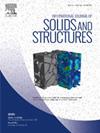A numerical study on the physical couplings of a geometrically linear thermo-chemo-mechanical model
IF 3.4
3区 工程技术
Q1 MECHANICS
International Journal of Solids and Structures
Pub Date : 2024-12-11
DOI:10.1016/j.ijsolstr.2024.113162
引用次数: 0
Abstract
Physically coupled models are used in various research fields to solve problems concerning the interaction of solid materials with thermal, chemical or electrical boundary conditions. If beside the mechanical fields two or more additional fields (e.g. temperature and concentration) have to be taken into account, the determination of the impact on the mechanical fields (e.g. stress and yield strength) and the influence of the boundary conditions leads to an ambitious task. To deal with this issue, a thermo-chemo-mechanical model using a geometrically linear theory and a thermodynamically consistent derivation, is presented. The model is specified for linear elastic isotropic solid materials. A fully coupled set of partial differential equations is obtained. A Finite Element implementation using the User Element subroutine of ABAQUS is performed. A detailed description about the steps necessary to derive the corresponding element formulation is provided, thereby supporting the development of user-defined elements. The user-defined element is used for a series of simulations involving submodels with up to seven different combinations of active fields including thermo-chemical, thermo-mechanical and chemo-mechanical couplings. Three sets of boundary conditions are considered, leading to closed and open systems. This procedure, which is exemplified in one- and three-dimensional examples, enlightens strong and weak couplings and outlines the mechanical role on the interaction between the solid material and the chemical environment. Additionally, the implications of a geometrical linearization on the interpretation of the concentration is illustrated.
求助全文
约1分钟内获得全文
求助全文
来源期刊
CiteScore
6.70
自引率
8.30%
发文量
405
审稿时长
70 days
期刊介绍:
The International Journal of Solids and Structures has as its objective the publication and dissemination of original research in Mechanics of Solids and Structures as a field of Applied Science and Engineering. It fosters thus the exchange of ideas among workers in different parts of the world and also among workers who emphasize different aspects of the foundations and applications of the field.
Standing as it does at the cross-roads of Materials Science, Life Sciences, Mathematics, Physics and Engineering Design, the Mechanics of Solids and Structures is experiencing considerable growth as a result of recent technological advances. The Journal, by providing an international medium of communication, is encouraging this growth and is encompassing all aspects of the field from the more classical problems of structural analysis to mechanics of solids continually interacting with other media and including fracture, flow, wave propagation, heat transfer, thermal effects in solids, optimum design methods, model analysis, structural topology and numerical techniques. Interest extends to both inorganic and organic solids and structures.

 求助内容:
求助内容: 应助结果提醒方式:
应助结果提醒方式:


